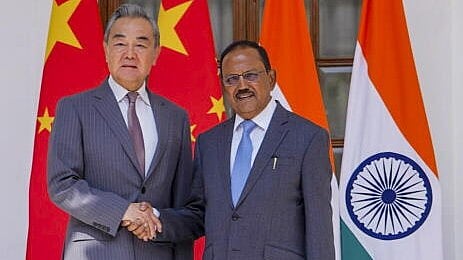
NSA Ajit Doval with Chinese Foreign Minister Wang Yi
Credit: PTI Photo
New Delhi: The India-China border areas have been quiet in the past nine months, National Security Advisor Ajit Doval said on Tuesday, a day after External Affairs Minister S Jaishankar stressed the withdrawal of additional troops deployed by both sides along the Line of Actual Control during the 2020-2024 military stand-off in eastern Ladakh.
Doval and Chinese Foreign Minister Wang Yi met in New Delhi and held the 24th round of negotiations to settle the dispute over the boundary between India and China.
“There has been an upward trend (in the bilateral relations) in the past nine months,” Doval told Wang at the beginning of the boundary negotiations on Tuesday. He was referring to the efforts being made by India and China to mend the ties after the four-and-a-half-year-long military stand-off along the LAC in eastern Ladakh came to its end in October 2024. “Borders have been quiet. There has been peace and tranquility. Our bilateral engagements have been more substantial.”
Doval’s comment on peace and tranquillity along the disputed boundary between India and China came a day after Jaishankar met Wang in New Delhi and told him that the de-escalation process – withdrawal of additional troops deployed by both sides along the LAC – should “move forward”. Jaishankar also linked the positive momentum in India-China bilateral relations with the maintenance of peace and tranquillity along the disputed boundary.
The stand-off along the LAC in eastern Ladakh had started in April-May 2020 with the aggressive deployment of a large number of troops by the Chinese People’s Liberation Army along the disputed boundary between the two nations, and the Indian Army responding with counter-deployment. It reached a flashpoint with a violent face-off in Galwan Valley on June 15, 2020. The protracted negotiations led to the disengagement or mutual withdrawal of frontline troops from the face-off points – Galwan Valley, northern and southern banks of Pangong Tso, Gogra Post, Hot Springs and finally Depsung and Demchok – along the LAC.
The two sides, however, could not make much progress on the disengagement, despite the resumption of the negotiations between Special Representatives to resolve the protracted boundary dispute in December 2024. Though the mutual withdrawal of frontline troops from the face-off points was completed, China did not pull back its soldiers from the “rear areas”, forcing India to maintain the same level of deployment.
The 1993 and 1996 agreements between India and China required both sides to refrain from amassing large numbers of troops in the border areas, to abide by and respect the LAC strictly and to avoid taking any unilateral action to alter it.
During his meeting with Wang on Tuesday, Doval referred to Prime Minister Narendra Modi’s meeting with Chinese President XI Jinping on the sidelines of the BRICS summit at Kazan in Russia on October 23, 2024, immediately after the deal on patrolling in Depsung and Demchok areas formally ended the stand-off along the LAC in eastern Ladakh.
“The new environment that has been created has helped us in moving ahead in the various areas that we were working on,” Doval told Wang.
Wang said that the two sides should “increase mutual trust through strategic communication, expand common interest through exchanges and cooperation, and properly settle the specific issues” along the boundary. “We are heartened to see the stability that is now restored in the borders,” said the foreign minister of China.
